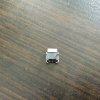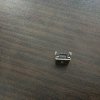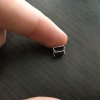Hi everyone,
I am new to these boards and pretty new to electronics and repairs, so any help would be really appreciated.
I have an older Elgato "Game Capture HD" Capture Card for capturing video via HDMI. They are known for having issues with the mini USB port. After opening it up, it is easy to see why. The mini USB port is not soldered or held down very well at all. The port is simply put into place, and it jiggles a lot. It causes problems if you bump it or move it even slightly while connected. While trying to realign the five pins on the mini USB port so it wouldn't lose contact as easy, I accidentally broke one of them off. I still have the pin, but I highly doubt that I could reattach it because it is so small. There are three pictures of the broken port.
I looked around online for replacement mini USB ports, but couldn't find the exact same kind. I have attached three pictures of the closest five pin mini USB port I was able to find. I don't know much about differences between five pin mini USB ports. Is this even the right kind?
I also have attached pictures of how the port fits onto the board.
I have a little bit of soldering experience under my belt, and tools to do simple soldering, but I don't want to do anything that may break the Capture Card or my computer when I hook it up. Does anyone have any ideas on how I could get this working again? I can look up and give more detailed information if necessary.
I would really appreciate any help I can get. These capture cards are expensive, so if at all possible I would like to avoid having to buy a new one. Thanks in advance!
I am new to these boards and pretty new to electronics and repairs, so any help would be really appreciated.
I have an older Elgato "Game Capture HD" Capture Card for capturing video via HDMI. They are known for having issues with the mini USB port. After opening it up, it is easy to see why. The mini USB port is not soldered or held down very well at all. The port is simply put into place, and it jiggles a lot. It causes problems if you bump it or move it even slightly while connected. While trying to realign the five pins on the mini USB port so it wouldn't lose contact as easy, I accidentally broke one of them off. I still have the pin, but I highly doubt that I could reattach it because it is so small. There are three pictures of the broken port.
I looked around online for replacement mini USB ports, but couldn't find the exact same kind. I have attached three pictures of the closest five pin mini USB port I was able to find. I don't know much about differences between five pin mini USB ports. Is this even the right kind?
I also have attached pictures of how the port fits onto the board.
I have a little bit of soldering experience under my belt, and tools to do simple soldering, but I don't want to do anything that may break the Capture Card or my computer when I hook it up. Does anyone have any ideas on how I could get this working again? I can look up and give more detailed information if necessary.
I would really appreciate any help I can get. These capture cards are expensive, so if at all possible I would like to avoid having to buy a new one. Thanks in advance!
Attachments
-
 IMG_2859.JPG516.5 KB · Views: 97
IMG_2859.JPG516.5 KB · Views: 97 -
 IMG_2860.JPG567.7 KB · Views: 105
IMG_2860.JPG567.7 KB · Views: 105 -
 IMG_2861.JPG364 KB · Views: 90
IMG_2861.JPG364 KB · Views: 90 -
 IMG_2862.JPG409.6 KB · Views: 105
IMG_2862.JPG409.6 KB · Views: 105 -
 IMG_2863.JPG354.2 KB · Views: 83
IMG_2863.JPG354.2 KB · Views: 83 -
 IMG_2864.JPG408.7 KB · Views: 93
IMG_2864.JPG408.7 KB · Views: 93 -
 IMG_2865.JPG322.1 KB · Views: 65
IMG_2865.JPG322.1 KB · Views: 65 -
 IMG_2866.JPG330.1 KB · Views: 96
IMG_2866.JPG330.1 KB · Views: 96 -
 IMG_2867.JPG372.3 KB · Views: 90
IMG_2867.JPG372.3 KB · Views: 90
Last edited:


